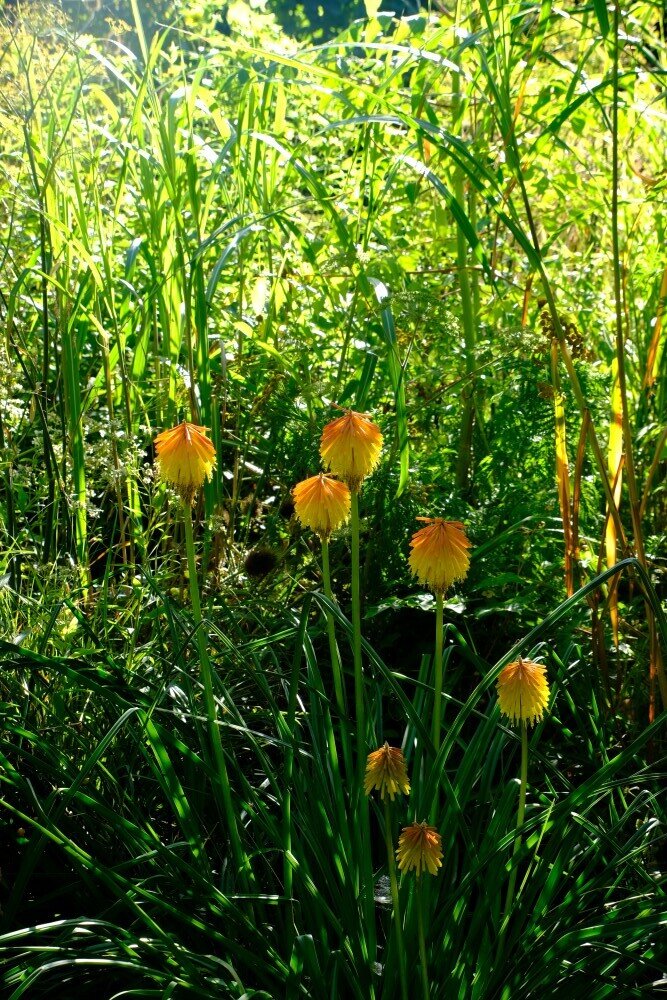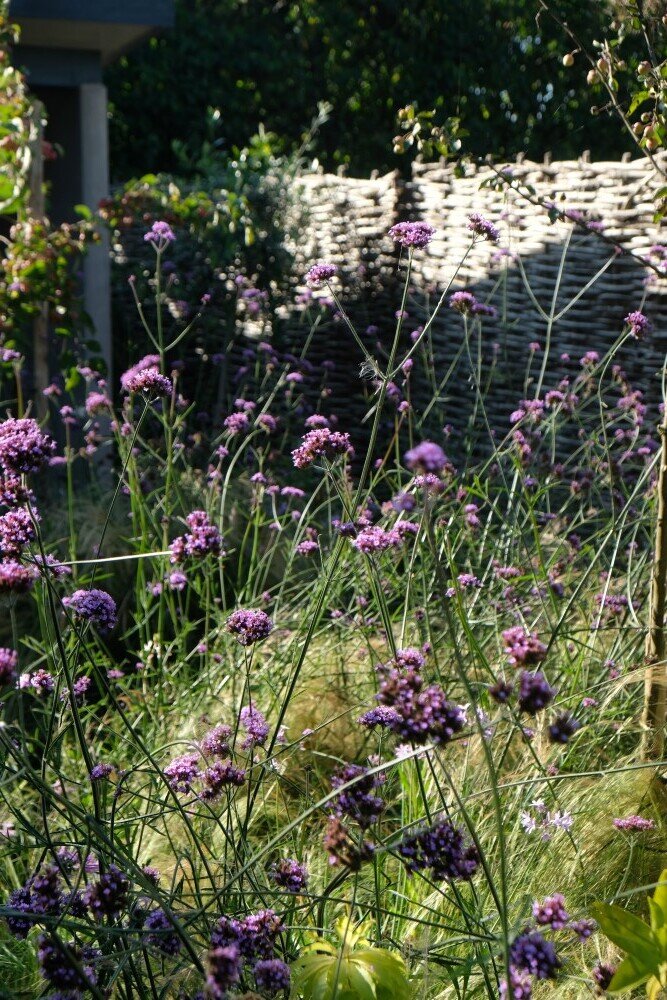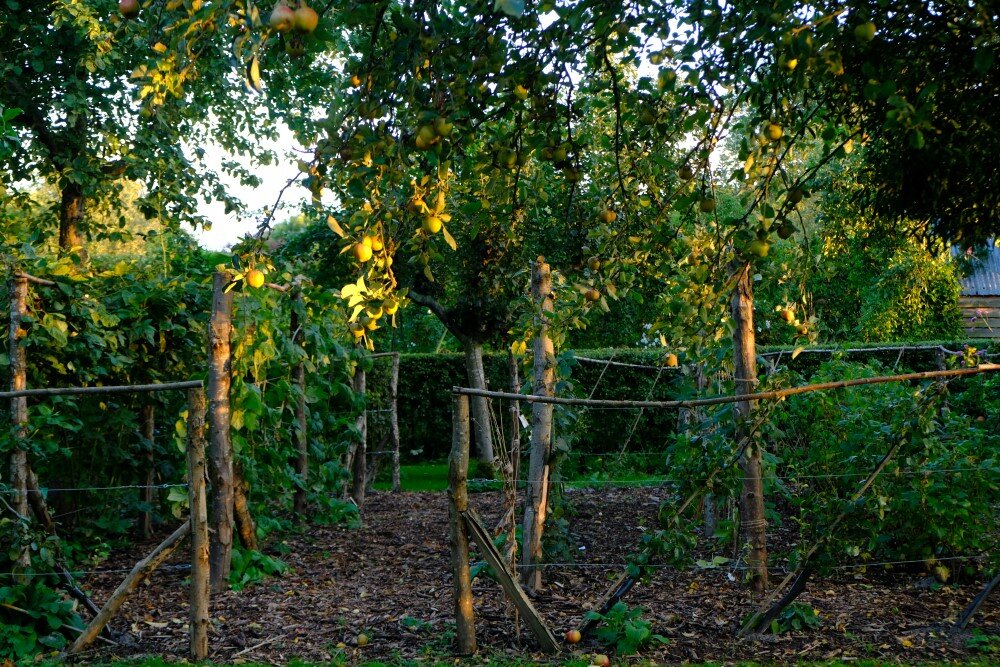September 2020
The weather in August was pretty miserable here in the garden. We had a swelteringly hot, humid first half followed by constant, wind, gales and then unseasonable cold. It felt as though the seasons had skipped a month and October was knocking at the door. But September is the mediator. It is the true link between summer and autumn and, in its gentle light and slow drift can be one of the loveliest times of the year.
A September garden acquires the colours and textures of a fading but still rich tapestry. The colours and light in the garden are daily being gently stretched thinner and the light drifts through the leaves of the trees and hedges like smoke.
However, on a fine day in early September the Jewel garden can be at its best. Sunflowers, dahlias, cannas, tithonias, Zinnias and cosmos all continue to fill the borders with splashes of bright, strong colour. In the Cottage Garden there is a last flurry of roses with the second, all-too-brief flowering.
The Grass Borders start to really come into their own and are the glory of the garden, the green foliage becoming to silvers, golds and bronzes before autumn leaves it tawny and sun-bleached.
The vegetable garden gives its most abundant harvest throughout September and eating from a September garden means dining well, every day. Many of the plants like celery, celeriac, pumpkins, climbing beans, chicory and Florence fennel come to perfection and many more, like all the salad leaves, spinach, chard or beans are still going strong whilst the winter brassicas are beginning to be ready for harvest.
In all, this is one of my favourite times in the garden. Along with lots of good flowers and masses of ripening fruit and vegetables, the fading elegance gives it dignity and the knowledge that every fine day is one of the last makes them precious.
BOOKS
I have two new books published this month.
‘My Garden World’ which I wrote mainly during the first half of this year but based upon notes made during the past 30 years, was always set for a publication date of 17th September.
However, due to the coronavirus pandemic, the publication of ‘American Gardens’, based upon my visits to gardens in the States last year, with photographs by Derry Moore, was delayed from its original publication spot during Chelsea Flower Show week in May to September 22.
So two very different books, with different publishers will appear within a few days of each other.
‘American Gardens’ is based upon three journeys I made last summer, during which we filmed the three programmes for the BBC of ‘Monty Don’s American Gardens’. It is every bit as much Derry’s book as mine and filled with his superb photographs.
However ‘My Garden World’ is very personal and although there are photographs, they are all taken by me. It is an account of all the wildlife that I share our garden and farm with, from insects and wild flowers to the birds of prey and mammals I am privileged to see.
Both books will be available from good bookshops and via the links below:
What to do in the garden this month:
As always in the garden, many jobs roll over from month to month, be it weeding, deadheading or mowing the grass. Above all continue to deadhead daily, cutting back spent blooms to the next leaf - even if that means taking off quite a long length of stem. Carry on collecting seeds as they ripen - and before they disperse - and once really dry, store them in a jar or paper envelope (NOT a plastic bag) in the fridge until you are ready to use them.
TAKING CUTTINGS
If you have not taken cuttings before - do not be daunted. They are easy, mostly successful and the gateway to producing scores of new plants for free. They also enable you to be very specific about what you want. A plant grown from a cutting will always be exactly the same as its parent plant whereas one grown from seed will always be different - albeit perhaps not very much and perhaps be an improvement. But cuttings are essentially clones so if you have a favourite rose or a particularly delicious gooseberry or a really good upright rosemary bush then all these qualities will remain with the new plants grown from cuttings.
Semi ripe cuttings are taken from current season’s wood that has started to harden off a little. The tip is soft and bendy but the base of the cutting will have wood that has started to become more rigid. This means that it will be slower to make new roots than a soft cutting but also be slower to die back and this allows for more flexibility and a much reduced sense of urgency about the whole proceedings.
Before you set put to take any cuttings have with you a plastic bag and a sharp knife and secateurs. The bag is for placing the cut material immediately into to reduce moisture loss and the sharper your cutting implements the more likely they are to root. In principal it is best to take cuttings in the morning whilst the plant is full of moisture but in practise it is something best done as and when you are minded to do it. No time like the present!
Always choose healthy, strong, straight growth for cutting material. It should be free from any flowers or flower buds. Plants like rosemary will root successfully from side shoots that have been peeled from the main stem but where there is plenty of material I prefer to take shoots with the growing tip intact.
Once you have taken material from the plant and placed it in the polythene bag go and pot them up immediately. The cuttings are effectively dying from the second you cut them until they develop new roots so the quicker you can aid that process to happen the more likely you are to have success. Strip off all lower leaves and side shoots so that only an inch or less of foliage remains. Cut the bare stem to size with a sharp knife or secateurs and bury it in a container of very gritty or sandy compost.
It is best to place the cuttings around the edge of a pot and you can always get at least 4 and often more in one container. Put this somewhere warm and bright but not on a south-facing windowsill as it may scorch. Water it well and then keep it just moist but a daily spray with a mister will help stop the leaves drying out before new roots have time to form. You will know that the roots have formed when you see fresh new growth. At that point the cuttings can be removed from the pot and potted on individually before planting out next spring.
SOW GRASS SEED/REPAIR LAWNS
This is an ideal time of year to either sow or turf new grass or to repair patches and worn areas on your lawn.
If it is just a worn area of thin grass, rake away all thatch and moss and remove all weeds and thinly scatter grass seed, watering well and keeping it damp. The seed should germinate and grow in days. Do not mow it for at least a month and if it looks unsightly going into winter clip the new growth with shears.
For a larger area clean the edges with a sharp spade, fork it over to remove any compaction and either scatter with seed or cut a piece of turf to fit, making sure that the edges are butted tightly against the existing grass.
Like grass seed, it is important that turf should not be walked on or mown until growing vigorously which will indicate that the roots have become established and are growing strongly. Depending on the weather, this may mean leaving it uncut until next spring.
AERATE LAWNS
Even if your lawn has come through this summer unscathed, it is always a good idea to aerate it at this time of year. You can use a fork by working the tines into the ground at 12 inch intervals or, for a larger lawn, hire a rolling hollow-tine or slitter. Ideally this is followed by working sand into the holes they create with a stiff brush. Finally give the grass a thorough scratch with a wire rake, to remove all the thatch and moss and whilst it will look a little threadbare this autumn, next spring your lawn will be rejuvenated for this autumnal working over.
APPLES
Start to pick over any apples at least once a week, checking to see if any are ripe by holding them in the palm of your hand and gently lifting and twisting to see if the stalk comes away easily. Do not force it as when it is ready they always pick very easily.
If apples are to be stored successfully - and if carefully placed in a cool, dark fairly moist place they will keep for months - they must be picked without any bruises or blemishes and any windfall, however seemingly perfect, will not keep and should be eaten fresh or cooked and then frozen.
If you have more windfalls than you can possibly eat or process, consider hiring an apple press to make juice which can then be bottled and stored.
PLANT BULBS IN POTS
Spring bulbs are now on sale but the ground is often much too hard to plant them in grass at this stage of the year, so I always begin by planting some bulbs in pots.
I start with crocus, daffodils - especially smaller ones like ‘tete a tete’ - reticulate irises, muscari and scillas. These need not be special or different from those in your borders or grass but will flower a little earlier and can be positioned to maximum effect next spring.
Choose an attractive pot which need not be deep - a terracotta pan is ideal - and can be very small - a few crocus in a small pot can cheer the darkest February day. However, you will need to mix your compost with some grit to make sure the drainage is good and the bulbs do not become waterlogged over winter. Place the planted pots in a sheltered position ready to move into the sun when new growth appears.
PLANT HARDNECK GARLIC
There are two types of garlic, hardneck and softneck. The type you mostly buy is softneck which has a plaitable stem, stores well (which is why shops stock it) and is often excellent. But the best, tastiest garlic is hardneck which has a stiff, upright stalk and because it is much harder to buy it makes sense to grow it yourself.
Hardneck varieties such as ‘Red Duke’, ‘Rocambole’, or ‘Early Purple Wight’ are slower to grow so should be planted now, a month or more before softneck varieties.
Like all garlic of any type, plant plump individual cloves (the bigger the clove the bigger the bulb it will generate) about 6 inches apart, pointed end up and buried a good inch below the surface in good but well-drained soil. Shoots will appear in about 6-8 weeks.
PRUNING SHRUB ROSES
I know that some gardeners are anxious about pruning roses but the many shrub varieties such as the gallicas, ‘english’ roses, albas or Hybrid Perpetuals are best simply trimmed with shears any time this month.
Do not worry about the position or angle of the cuts but clip away all long, straggly shoots as though you were trimming a hedge, leaved a compact, slightly domed bush that is about two thirds of its former size. In March, when you can see clearly without any foliage, you can inspect the shrub to remove any damaged or rubbing stems, but a simple shear in September is enough to keep it healthy and packed with flower next year.
PRUNING SUMMER-FRUITING RASPBERRIES
The old brown canes of summer-fruiting raspberries can now all be cut down to the ground, leaving the fresh new green canes standing. These new canes will carry next summer’s crop.
It is a good idea to reduce these to the half dozen strongest shoots, taking out all smaller or awkwardly positioned growth. The remaining canes will need holding securely for the next year and therefore summer raspberries are best grown against a permanent system of support.
I tie the canes with twine to parallel wires fixed strongly between robust posts, weaving round them and fanning them out them evenly as I work along the wire at each level. It is important that it is really secure as winter winds can catch and damage them.
PLANTING BIENNIALS
Now - and over the coming weeks - is the ideal time to plant out biennials like foxgloves, wallflowers and honesty. Trays of plants can be bought and make a note to sow seed next May and June. Biennials germinate and establish foliage in one growing season and then produce their flowers the next having lasted through winter. They provide some of our best and most loved garden flowers and planted now will establish a good root-system in the soil, hunker down over the worst of winter and then start to grow again as soon as the weather warms up, ready for flowering in Spring and summer before setting seed and dying back.



























